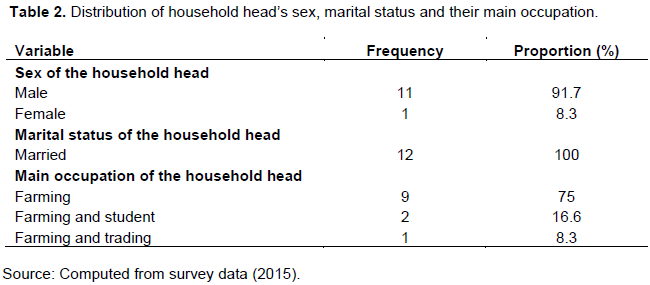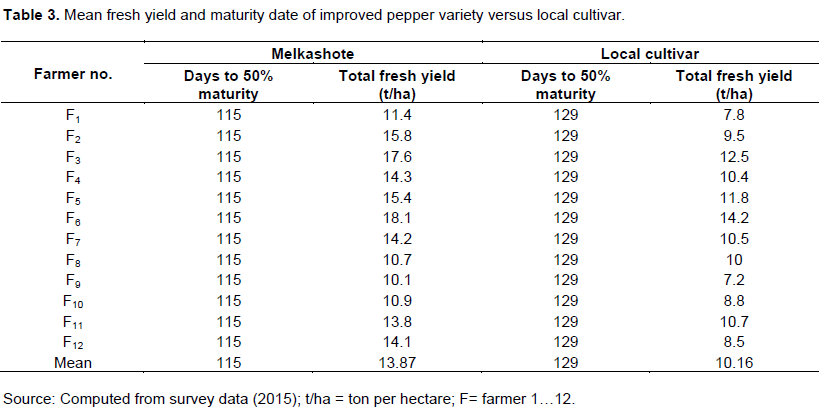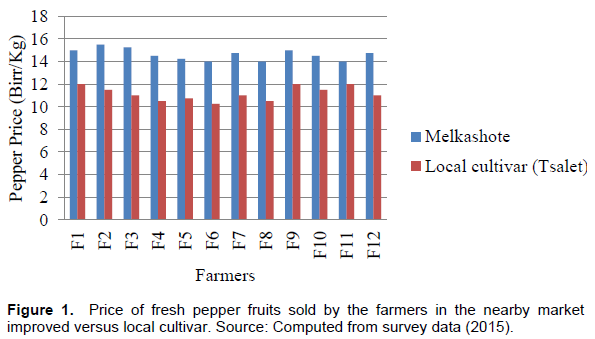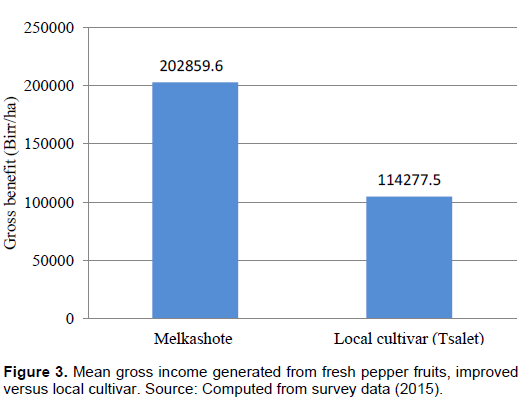ABSTRACT
The demonstration was conducted in 2014/15 production season at Tanqua-Abergelle district, particularly at Hadash-Tekhli (Zembaw) irrigation scheme at farmers’ land. The scheme has high irrigation potential for horticultural crops production. But, improved technologies have not yet demonstrated. Therefore, the objective of this research was to demonstrate improved variety of pepper with improved management practice in to the irrigation scheme. The improved pepper variety (Melkashote) and local cultivar, ’Tsalet’ were used in the demonstration. The mean fresh fruit yield obtained from the improved pepper variety was higher (13.87 t/ha) than the local cultivar (10.16 t/ha). This shows 36.5% fresh pepper fruits yield increment over local cultivar, implying yield productivity per unit area can be increased by using the improved pepper variety. In addition, the improved pepper variety (Melkashote) required 115 days to mature whereas the local cultivar matured in 129 days. This shows the improved pepper variety was earlier in maturity than the local cultivar. In terms of monetary value, an average gross income of 202,859.60 Birr/ha or US$ 96,46.33 per hectare was generated from the improved pepper variety while from the local cultivar was 114,277.50 Birr/ha or US$ 5,434.10 per hectare. This implies the farmers were able to generate more income from the improved pepper fresh yield over the local cultivar. Besides, based on farmers’ perception results, except the attributes of fruit size, most of the respondents had favored the improved pepper variety (Melkashote) in its productivity, fruit length, fruit color, maturity, insect and disease resistance, marketability, fruit quality and taste than the local cultivar (Tsalet). Hence, the farmers decided to grow the variety in the next production season. Therefore, further popularization and scaling out activities should be done by the research center and office of agriculture and rural development of the district.
Key words: Farmers’ perception, maturity, Melkashote, Tsalet, yield.
Pepper fruit (Capsicum species) is one of the most important vegetable crops. Capsicum species popularly known as pepper is the world’s second most important crop after tomato (Yoon et al., 1989). According to Bosland (1994) the genus Capsicum belongs to the family Solanaceae. Cobley and Steele (1976) reported that apparently between 5200 and 3400 B.C, the native of Americans were growing Capsicum, which places it among the oldest cultivated crops. Adamu et al. (1994) reported that Nigeria is the largest producer of pepper in Africa, accounting for about 50% of the African production. The plant is an herbaceous annuals usually growing from 45 to 65 cm tall.
It is a relish in most African diets. It serves as a spice and is rich in vitamin C (Espig, 1991). Pepper is a short-lived herb normally grown as annual. Peppers are adapted to high temperatures, but excessively hot weather may produce infertile pollen and reduce fruit set. Temperatures above 32°C may also cause excessive transpiration resulting in dropping of buds, flowers and fruits. A drop in temperature to 16°C at flowering may result in poor fruit or seedless fruit. Plants are tolerant of slightly acid soils but a pH of 5.5 to 6.6 is preferable.
Like other vegetable crops, pepper has many advantages. Pepper has always been regarded as the king of spices. Highly treasured and a precious commodity it was used in the past for trading exchanged like money. Consumption of pepper accounts for about 20% of the average vegetable consumption per person per day in Nigeria (Erinle, 1989; Alegbejo, 2002). It is used in the preparation of soup and stew, which are among the major essential compliments of staple based on cereals and root crops and also forms remedies for toothache and sore throat (Bosland, 1994; Leung and Foster, 1996). The capsaicin extract from sweet pepper is used in pharmaceuticals as a counter irritant balm (Purseglove, 1997). In Japan and China, it is used topically in an ointment form to treat myalagia (But, 1997) and in Germany; it is approved as a topical ointment for the relief of painful spasm. Capsicum is regarded as a neuropathetic pain reliever; therefore it is used in the treatment of diabetic neuropathy and also in the management of surgical neuropathic pain in cancer patient (Messiaen, 1992).
Abergelle Agricultural Research Center had carried out pepper adaptation trials to evaluate the yield potential of pepper varieties and cultivars in farmer’s field in Adiha irrigation scheme. As a result, potential and promising high yielding improved pepper varieties were identified and an average fresh fruit yield of 12.87 and 9.93 t/ha were obtained from Melkashote and Marakofana, respectively. Therefore, demonstration of one of the best performed improved pepper variety with its improved production technologies is found to be important in Tanqua-Abergelle district particularly at Hadash-Tekhli (Zembaw) irrigation scheme. This research was conducted to:
1. Demonstrate the improved pepper variety (Melkashate) and its management practices; and
2. Collect farmer’s perception about the performance of improved pepper variety versus local cultivar.
Description of the study area
The demonstration trial was conducted in Tanqua-Abergelle district, particularly at Hadash-Tekhli (Zembaw) irrigation scheme at farmers’ land during 2015 production season. The district is located in central zone of Tigray which is 120 km to the West of Mekelle. It is located at Latitude 13° 14’ 06”N and longitude 38°58’50” E. It has area coverage of 144,564 ha and the average land holding per house hold is estimated to be 1.84 ha. It is agro-ecologically characterized as hot warm sub-moist low land (SMl-4b) below 1500 m.a.s.l, however; altitude ranges between 937 and 2370 m.a.s.l. The mean annual rainfall and temperature ranges between 400 and 600 mm and 21 to 41°C, respectively. It has 20 kebelles of which 19 are rural kebelles. Major soil type of the district is sandy soil followed by clay and clay loam. Mixed farming system is dominantly practiced in the district. Major crops grown in the district are; sorghum, maize and pulses (cowpea, ground nut, sesame). The district is also well known for its large number of livestock resources (sheep and goats) and poultry (TADOoARD, 2015).
Farmers research group (FRG) establishment
This demonstration was carried out through the participation of farmers. Farmers Research Group (FRG) was established based on their interest and willingness. It was demonstrated in 10 m × 10 m plot size with 12 farmers and the total land area covered was 0.12 ha. Before execution of the demonstration, training was given to the farmers about FRG concepts, pepper production and managements, seed production techniques and maintenance. Pepper seeds were provided to the farmers by the research centre. They evaluated the performance of the crop according to their time of schedule from transplanting up to harvesting. During participatory monitoring and evaluation, FRG members were evaluating the performance of the improved pepper variety (Melkashote) versus local cultivar both for its yield and farmers’ perception on the attributes of the improved variety.
Plant establishment
Pepper seed at a rate of 600 g/ha was used. In nursery site, the seeds were planted in well prepared seed bed and mulched with grass. Around 45 to 55 days after sowing or 3 to 4 true leaf stages, 12 to 15 cm tall, healthy and vigorous seedlings were transplanted to farmers’ field. The seedlings were planted in spacing of 70 and 30 cm between rows and plants. After transplanting, fertilizers were applied at a rate of 200 kg/ha DAP and 100 Kg/ha urea in split form (50% during planting and 50% after one and half month).
Data collection and analysis
Sowing date, transplanting date, days to 50% maturity, marketable yield, near by market price and farmers’ perception data were collected. Five kilograms of ripened pepper fruit samples were taken to evaluate the improved pepper variety (Melkashote) versus the local cultivar. The data collected were analyzed using IBM SPSS statistics version 20.0 and Microsoft excel.
Demographic characteristics of the households
The mean age of the household heads was 38.17±9.44 while the minimum and maximum ages were 28 and 56, respectively. This implies all the participated farm households in the demonstration of improved pepper versus local cultivar were at the working ages and could handle the difficult nature of irrigation activities. The average family size of the households was 5±1.41 heads per household and the minimum and maximum households’ family size was 3 and 10, respectively. This indicates the participated farm households were able to hire and engage their families in the irrigation activities. The minimum and maximum educational status or last grade completed of the households were 2 and 8, respectively while the average educational status or last grade completed of the households was 5.75±1.82 (Table 1). This implies most of the participated farm households were about grade 5 which can easily adopt the demonstrated technology, management practices and seed production techniques.

From the overall participated households, majority (91.7%) were male. All the participated farmers were married (100%). Majority (75%) of participated farm households’ main occupation was farming, 16.6% farming and schooling and 8.3% was involved in farming and trading (Table 2).
Pepper fresh fruit yield and days to maturity
The mean fresh fruit yield obtained from the improved pepper variety was higher (13.87 t/ha) than the local cultivar (10.16 t/ha). This shows 36.5% fresh pepper fruits yield increment over local cultivar, implying yield productivity per unit area can be increased by using the improved pepper variety. A maximum of fresh yield (18.1 t/ha) was also recorded from Melkashote while the maximum fresh yield from the local cultivar was 14.2 t/ha. In addition, on average the improved pepper variety (Melkashote) required 115 days to mature whereas the local cultivar matured in 129 days during the demonstration period (Table 3). This implies the improved variety matured earlier than the local cultivar. Hence, the farmers decided to grow the variety in the next production season.
Market prices and gross income generated from sales of fresh pepper fruits
Price of fresh fruits of the improved pepper variety had better price than the local cultivar. This implies
melkashote pepper fruit has got great market demand than the local cultivar (Figure 1).
Mean price of fresh fruits of the improved pepper variety sold by the farmers was 14.63 Birr1/Kg or US$ 0.78/Kg while the local cultivar was 11.25 Birr/Kg or US$ 0.53/Kg (Figure 2). This implies melkashote pepper fruit had better price over the local cultivar.
Mean gross income generated from the improved pepper variety sold by the faremers was 202,859.60 Birr/ha or US$ 96,46.33 per hectare while the local cultivar was 114,277.50 Birr/ha or US$ 5,434.10 per hectare (Figure 3). This implies the farmers were able to generate more income from melkashote pepper fruit sol in the market over the local cultivar.
Farmers’ perception on the attributes of pepper
Farmers’ perception were collected on the attributes of productivity, fruit weight, fruit size, fruit length, fruit color, maturity, insect and disease resistance, marketability, fruit quality, taste and shelf-life. Based on farmers’ perception results, except the attributes of fruit size, most of the respondents had favored the improved pepper variety (Melkashote) in its productivity, fruit length, fruit color, maturity, insect and disease resistance, marketability, fruit quality and taste than the local cultivar (Tsalet). However, about 41.7 and 66.7% of the respondents reported that there is no change in fruit weight and shelf-life, respectively between the improved hot pepper variety and the local cultivar. Equal number of respondents reported that fruit size (41.7%) of the improved pepper is good and poor (Table 4). Generally, most of the respondents had good perception based on the attributes of the improved hot pepper variety as compared to the local cultivar. Hence, the farmers decided to grow the variety in the next production season.

CONCLUSION AND RECOMMENDATIONS
As the study result shows, the improved pepper variety had better yield advantage over the local cultivar; hence the farmers were able to maximize more benefit or gross income. Besides, the improved pepper variety matured earlier than the local cultivar and awareness of the farmers on nursery management, transplanting, fertilizer application and other cultural practice of pepper increased. Hence, the farmers favored the improved pepper variety and decided to grow it in the next production season. Therefore, it can be recommended that: farmers should produce high yielding and early maturing improved hot pepper variety (Melkashote) instead of producing low yielding local pepper cultivar. Therefore, further popularization and scaling out activities should be done by the research center and office of agriculture and rural development of the district.
The authors have not declared any conflict of interests.
REFERENCES
|
Adamu SU, Ado U, Eruofor S, Olawrewaju, JD (1994). Variations in the fruit of pepper. Nig. J. Hort. Sci. 2:10-14.
|
|
|
|
Alegbejo MD (2002). Evaluation of pepper cultivars for resistance to pepper veinal mottle poliovirus in Northern Nigeria. J. Arid Agr. 12:93-103.
|
|
|
|
|
Bosland PW (1994). Chiles: History and uses. In: G Choriambus (ed), spices, herbs and edible fungi. New York, Elsevier publication. P.366.
|
|
|
|
|
But PH (1997). International collection of traditional and folk medicine. World scientific Organization Singapore P 210.
|
|
|
|
|
Cobley LS, Steele WM (1976) Introduction to the Botany of tropical Crops. Second Edition Longman London P 371.
|
|
|
|
|
Erinle JO (1989). Present status and prospects for increased production of tomato and pepper in Northern Nigeria. In: Tomato and pepper in the tropics AVRDC Shauhua Taiwan P 545.
|
|
|
|
|
Espig G (1991). The cultivated plants of the tropics and subtropics. Verlag Josef Margrat Scientific Books. Muhlustrasse 9, D-6992 Weikersheim West Germany P 552.
|
|
|
|
|
Leung AY, Foster S (1996). Encyclopedia of common natural ingredients used in food drugs and cosmetics, 2nd edition, New York: John Wiley and sons Inc.
|
|
|
|
|
Messiaen CM (1992).The tropical vegetable garden. Macmillan (London) P 235.
|
|
|
|
|
Purseglove JW (1997). Tropical crop dicotyledons. Longman Singapore P 718.
|
|
|
|
|
TADOoARD (Tanqua-Abergelle District Office of Agricultural and Rural Development) (2015). Annual report. Unpublished report.
|
|
|
|
|
Yoon JY, Green S, Tshanz A, Tsou S, Chenge L (1989). Pepper improvement for the tropics problems and approach. In: Tomato and Pepper production in the tropics. Asian vegetable research and development center. AVRDC Shantine Taiwan pp. 86-90.
|
|






